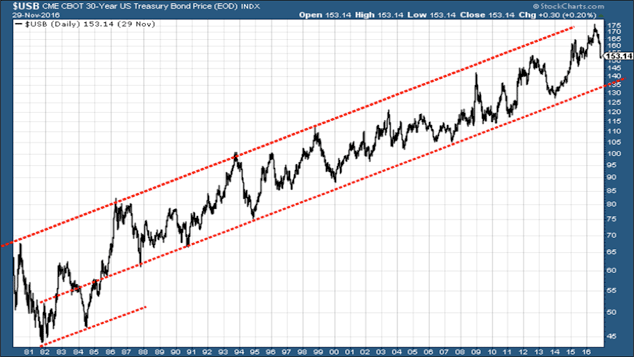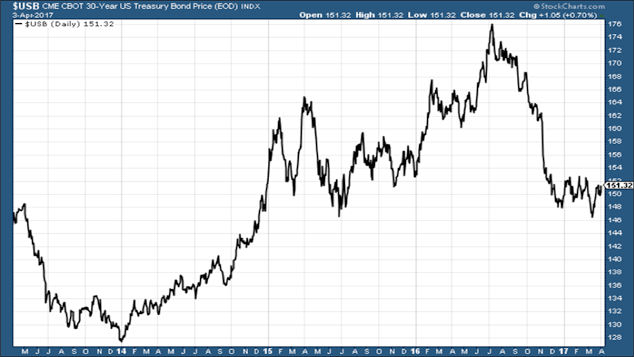What’s coming next – inflation, deflation or more muddling through?
Whether we can expect prices to rise or fall is one of the most important questions facings investors. Dominic Frisby looks to the charts for a clue.


Today we attempt to answer what is perhaps, from a strategic perspective, the most important question in investing.
What is coming next: inflation or deflation?
The answer to that question, if there is such a thing, determines how we allocate our portfolios.
MoneyWeek
Subscribe to MoneyWeek today and get your first six magazine issues absolutely FREE

Sign up to Money Morning
Don't miss the latest investment and personal finances news, market analysis, plus money-saving tips with our free twice-daily newsletter
Don't miss the latest investment and personal finances news, market analysis, plus money-saving tips with our free twice-daily newsletter
So let's see what we can come up with.
Inflation? Deflation? It's very hard to tell
In a pure inflationary scenario, the opposite applies. You don't want to hold any cash that loses value. Instead you want to own assets real estate, commodities, equities, precious metals, fine art and so on.
However, this is the modern day. Nothing is as simple as plain inflation or deflation any more. Through the 90s and the 00s, for example, we had "disinflation" when there is still inflation, but it's not as bad as it was, so that's good (apparently).
Then there's the issue of what inflation actually is. Central banks advise us, for example, that inflation is currently at 2% or 3%. They can tell us this because the prices of the goods and services by which they measure inflation have risen by 2% or 3%. They then set interest rates accordingly (or rather they don't, because in a more typical time period, our current levels of inflation would justify significantly higher rates).
Meanwhile, house prices might be rising at 10% per year, and equities prices by a similar amount. Your saved cash is buying you less and less, and you scratch your head and wonder what's going on, given that they said inflation was only 2%.
Deflation, on the other hand, is supposed to be a bad thing, because prices fall. But if the things you want to buy are getting cheaper, surely that's a good thing? If the price of some credit-driven asset is falling, the owners of the assets and those who suffer from the fall out might care, sure. But for others, it's an opportunity. It's all very much in the eye of the beholder.
Then there's the difference between official inflation and the original dictionary definition, which is the blowing up of the money (and credit) supply, leading to higher prices. Deflation is the reverse the shrinking of the supply of money and credit, leading to lower prices.
The whole issue is so obfuscated by different interpretations of the meanings of the words that it is almost impossible to know what one is talking about, let alone base an investment strategy around it.
Perhaps a better solution is to look at where interest rates are headed, although they themselves are manipulated and obfuscated by the opaque practice of printing money and using it to buy government bonds, aka quantitative easing (QE). Indeed, even although QE officially ended in the US at the end of 2014, the Federal Reserve is still buying bonds (it buys fresh bonds with the proceeds from old ones maturing).
Manipulation or not, the direction of rates is still a vital question. And it's one I struggle to answer with any confidence. I suspect the US will lead it usually does and the rest of the world will follow. So I look to the direction of the US Long Bond (the 30-year US Treasury) for clues. If bond prices are rising, rates are falling and vice versa.
Where are bond markets headed?
Here's the chart of the Long Bond price (rather than yield) since 1980. I've defined the trend with dotted red lines.

The peak of the market so far came in at $176 in July 2016.
What remains to be seen is whether that level will remain the peak or whether, one day, we go higher. It would seem unlikely, impossible even but never say never. A yield of 0.5% seemed impossible once. Who's to say we won't see negative rates, or something equally preposterous?
At present, we are in the middle of the trading range, at $153. Some are saying that the bond bull market is over. I'm not so sure.
I remember the carnage of 2008, when bond prices went above $140. I didn't think they could ever go any higher then and here we are. So I'm not calling a bear market until bond prices go below that lower red dotted line, which currently sits around $135.
In the shorter term, however, things do not perhaps look quite so bullish. Here's a chart since 2014 (the last time bond prices flirted with the lower red line).

You can see the big sell-off that began in July 2016. It accelerated with the election of Trump and his inflationary pledges to spend on infrastructure. This year prices have stabilised in a range around the $150 mark.
The short-term sentiment and momentum readings are almost all at extreme levels, which would point towards some kind of rally, but I don't feel confident enough about this market to place any sort of meaningful bet.
Current projections seem to be that we'll get another US rate rise in June and another in the autumn, which would imply lower bond prices. But I'm not sure those rises will happen. I often think that the Fed is making it up as it goes along, same as the rest of us but we'll see.
There are so many bubbles that will go pop if rate rises go too far too fast, so the Fed knows that it will have to tread softly. One possibility is that markets can handle higher rates at least for a time. Another is that they can't and volatility returns.
All in all there's so much that could happen, there's so much "what if?" that, if I had to bet on how this pans out over the next 18 months, I'm inclined to say the most likely outcome is more of the same though slightly different.
We range trade in other words. Interest rates go up, but only by a little bit. We get neither the hyperinflation nor the deflationary bust that the more extreme forecasters are projecting. There is a bit of inflation and a bit of deflation. The two opposing forces continue to exert their pressure, but neither wins out for now.
The world keeps on muddling through, in other words, and the inflation-deflation question remains unresolved.
Get the latest financial news, insights and expert analysis from our award-winning MoneyWeek team, to help you understand what really matters when it comes to your finances.
Dominic Frisby (“mercurially witty” – the Spectator) is as far as we know the world’s only financial writer and comedian. He is the author of the popular newsletter the Flying Frisby and is MoneyWeek’s main commentator on gold, commodities, currencies and cryptocurrencies. He has also taken several of his shows to the Edinburgh Festival Fringe.
His books are Daylight Robbery - How Tax Changed our Past and Will Shape our Future; Bitcoin: the Future of Money? and Life After the State - Why We Don't Need Government.
Dominic was educated at St Paul's School, Manchester University and the Webber-Douglas Academy Of Dramatic Art.
You can follow him on X @dominicfrisby
-
 Investors will reap long-term rewards from UK equities
Investors will reap long-term rewards from UK equitiesOpinion Nick Train, portfolio manager, Finsbury Growth & Income Trust, highlights three UK equities where he’d put his money
-
 The graphene revolution is progressing slowly but surely
The graphene revolution is progressing slowly but surelyEnthusiasts thought the discovery that graphene, a form of carbon, could be extracted from graphite would change the world. They might've been early, not wrong.
